

Category:Application layer protocols. This category includes protocols from the Application Layer of the Internet Protocol Suite as well as the protocols of OSI Layer 7.

The Application Layer of the Internet Protocol Suite includes Session Layer protocols and Presentation Layer protocols from OSI. Subcategories This category has the following 32 subcategories, out of 32 total. NETCONF. The Network Configuration Protocol (NETCONF) is a network management protocol developed and standardized by the IETF.
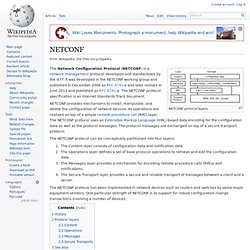
It was developed in the NETCONF working group and published in December 2006 as RFC 4741 and later revised in June 2011 and published as RFC 6241. The NETCONF protocol specification is an Internet Standards Track document. NETCONF provides mechanisms to install, manipulate, and delete the configuration of network devices. Its operations are realized on top of a simple remote procedure call (RPC) layer. The NETCONF protocol uses an Extensible Markup Language (XML) based data encoding for the configuration data as well as the protocol messages. Dynamic Host Configuration Protocol. The Dynamic Host Configuration Protocol (DHCP) is a standardized network protocol used on Internet Protocol (IP) networks for dynamically distributing network configuration parameters, such as IP addresses for interfaces and services.
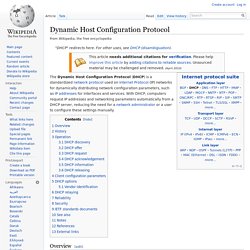
With DHCP, computers request IP addresses and networking parameters automatically from a DHCP server, reducing the need for a network administrator or a user to configure these settings manually. Overview[edit] Telnet. Telnet is a network protocol used on the Internet or local area networks to provide a bidirectional interactive text-oriented communication facility using a virtual terminal connection.
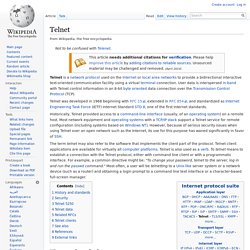
User data is interspersed in-band with Telnet control information in an 8-bit byte oriented data connection over the Transmission Control Protocol (TCP). Telnet was developed in 1968 beginning with RFC 15, extended in RFC 854, and standardized as Internet Engineering Task Force (IETF) Internet Standard STD 8, one of the first Internet standards. Simple Network Management Protocol.
Simple Network Management Protocol (SNMP) is an Internet-standard protocol for collecting and organizing information about managed devices on IP networks and for modifying that information to change device behavior.
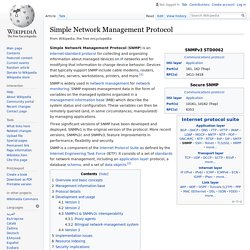
Devices that typically support SNMP include cable modems, routers, switches, servers, workstations, printers, and more.[1] SNMP is widely used in network management for network monitoring. SNMP exposes management data in the form of variables on the managed systems organized in a management information base (MIB) which describe the system status and configuration. These variables can then be remotely queried (and, in some circumstances, manipulated) by managing applications. Three significant versions of SNMP have been developed and deployed. Simple Mail Transfer Protocol. Short Message Peer-to-Peer. The Short Message Peer-to-Peer (SMPP) in the telecommunications industry is an open, industry standard protocol designed to provide a flexible data communication interface for the transfer of short message data between External Short Messaging Entities (ESME), Routing Entities (RE) and Message Centres.[1] SMPP is often used to allow third parties (e.g. value-added service providers like news organizations) to submit messages, often in bulk, but it may be used for SMS peering as well.

SMPP is able to carry short messages including EMS, Voice Mail notifications, Cell Broadcasts, WAP messages including WAP Push messages (used to deliver MMS notifications), USSD messages and others. Because of its versatility and support for non-GSM SMS protocols, like UMTS, IS-95 (CDMA), CDMA2000, ANSI-136 (TDMA) and iDEN, the SMPP is the most commonly used protocol for short message exchange outside SS7 networks. History[edit] Network Time Protocol. NTP is intended to synchronize all participating computers to within a few milliseconds of Coordinated Universal Time (UTC).[1]:3 It uses a modified version of Marzullo's algorithm to select accurate time servers and is designed to mitigate the effects of variable network latency.

NTP can usually maintain time to within tens of milliseconds over the public Internet, and can achieve better than one millisecond accuracy in local area networks under ideal conditions. Asymmetric routes and network congestion can cause errors of 100 ms or more.[2][3] The current protocol is version 4 (NTPv4), which is a proposed standard as documented in RFC 5905. It is backward compatible with version 3, specified in RFC 1305. History[edit] NTP was originally designed by David L. In 1979, network time synchronization technology was used in what was possibly the first public demonstration of Internet services running over a trans-Atlantic satellite network, at the National Computer Conference in New York.
Network File System. Network File System (NFS) is a distributed file system protocol originally developed by Sun Microsystems in 1984,[1] allowing a user on a client computer to access files over a network much like local storage is accessed.

NFS, like many other protocols, builds on the Open Network Computing Remote Procedure Call (ONC RPC) system. The Network File System is an open standard defined in RFCs, allowing anyone to implement the protocol. Versions and variations[edit] Sun used version 1 only for in-house experimental purposes. When the development team added substantial changes to NFS version 1 and released it outside of Sun, they decided to release the new version as v2, so that version interoperation and RPC version fallback could be tested.[2] NFSv2[edit] NFSv3[edit] Version 3 (RFC 1813, June 1995) added: At the time of introduction of Version 3, vendor support for TCP as a transport-layer protocol began increasing.
Hypertext Transfer Protocol. The Hypertext Transfer Protocol (HTTP) is an application protocol for distributed, collaborative, hypermedia information systems.[1] HTTP is the foundation of data communication for the World Wide Web.
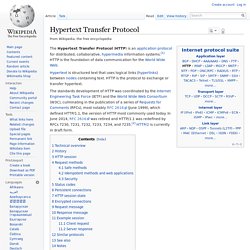
The standards development of HTTP was coordinated by the Internet Engineering Task Force (IETF) and the World Wide Web Consortium (W3C), culminating in the publication of a series of Requests for Comments (RFCs), most notably RFC 2616 (June 1999), which defined HTTP/1.1, the version of HTTP most commonly used today. In June 2014, RFC 2616 was retired and HTTP/1.1 was redefined by RFCs 7230, 7231, 7232, 7233, 7234, and 7235.[2] HTTP/2 is currently in draft form. Technical overview[edit] URL beginning with the HTTP scheme and the WWW domain name label. A web browser is an example of a user agent (UA). HTTP is designed to permit intermediate network elements to improve or enable communications between clients and servers. Gopher (protocol) The Gopher protocol /ˈɡoʊfər/ is a TCP/IP application layer protocol designed for distributing, searching, and retrieving documents over the Internet.
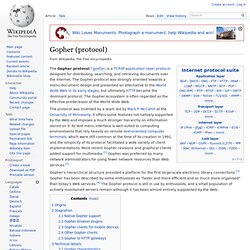
The Gopher protocol was strongly oriented towards a menu-document design and presented an alternative to the World Wide Web in its early stages, but ultimately HTTP became the dominant protocol. The Gopher ecosystem is often regarded as the effective predecessor of the World Wide Web. The protocol was invented by a team led by Mark P. McCahill at the University of Minnesota. It offers some features not natively supported by the Web and imposes a much stronger hierarchy on information stored on it. The original Gopher system was released in late spring of 1991 by Mark McCahill, Farhad Anklesaria, Paul Lindner, Daniel Torrey, and Bob Alberti of the University of Minnesota[5] in America. The World Wide Web was in its infancy in 1991, and Gopher services quickly became established. Some[who?] The top level menu of a Gopher server. File Transfer Protocol. FTP is built on a client-server architecture and uses separate control and data connections between the client and the server.[1] FTP users may authenticate themselves using a clear-text sign-in protocol, normally in the form of a username and password, but can connect anonymously if the server is configured to allow it.
For secure transmission that hides (encrypts) the username and password, and encrypts the content, FTP is often secured with SSL/TLS ("FTPS"). SSH File Transfer Protocol ("SFTP") is sometimes also used instead, but is technologically different. History[edit] The original specification for the File Transfer Protocol was written by Abhay Bhushan and published as RFC 114 on 16 April 1971. Domain Name System. The Domain Name System (DNS) is a hierarchical distributed naming system for computers, services, or any resource connected to the Internet or a private network. It associates various information with domain names assigned to each of the participating entities. Most prominently, it translates domain names, which can be easily memorized by humans, to the numerical IP addresses needed for the purpose of computer services and devices worldwide. The Domain Name System is an essential component of the functionality of most Internet services because it is the Internet's primary directory service.
The Domain Name System distributes the responsibility of assigning domain names and mapping those names to IP addresses by designating authoritative name servers for each domain. Authoritative name servers are assigned to be responsible for their supported domains, and may delegate authority over sub-domains to other name servers. Simple Sensor Interface protocol. The SSI ("Simple Sensor Interface") protocol is a simple communications protocol designed for data transfer between computers or user terminals and smart sensors.
The SSI protocol is an Application layer protocol as in the OSI model. The SSI protocol has been developed jointly by Nokia, Vaisala, Suunto, Ionific, Mermit and University of Oulu. Currently SSI is being developed within the Mimosa project, part of the European Union Framework Programmes for Research and Technological Development. The SSI protocol is used in point-to-point communications over UART and networking nanoIP applications. Session Initiation Protocol. SIP works in conjunction with several other application layer protocols that identify and carry the session media. Media identification and negotiation is achieved with the Session Description Protocol (SDP). For the transmission of media streams (voice, video) SIP typically employs the Real-time Transport Protocol (RTP) or Secure Real-time Transport Protocol (SRTP). For secure transmissions of SIP messages, the protocol may be encrypted with Transport Layer Security (TLS).
Network News Transfer Protocol. As local area networks and Internet participation proliferated, it became desirable to allow newsreaders to be run on personal computers connected to local networks. Because distributed file systems were not yet widely available, a new protocol was developed based on the client-server model. It resembled the Simple Mail Transfer Protocol (SMTP), but was tailored for exchanging newsgroup articles.